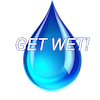Program Application
Phase I:
A full day of training for participating educators and future Get Wet! training facilitators which includes: Excel; sampling and laboratory procedures; GoogleMaps; and power point. Teachers will be directed to the Resources for Educators Page to manipulate useful PowerPoints and the curriculum book that contains geologic explanations of what groundwater is and how it is formed in their particular area. The page also includes specific directives for each technology used with hands-on activities, lists of vocabulary words, and homework lessons that apply to the parameters of each test performed in the classroom with the students well water samples. Individual state results are available electronically on each facilitating organization(s) website. The intention is to have data whereby teachers throughout the country can communicate and further readings can be made available.
Phase II:
Employ all grades and educators in the involvement of chemistry, geology, geodesy, mapping, GIS, statistics, computer programs, and environmental studies. Students should develop: field sampling techniques; laboratory skills; comprehension in terminology; a knowledge of local land-use effects on water quality; and an understanding of water chemistry testing (nitrates, alkalinity, chloride, pH, salinity, conductivity, metals, and turbidity). Classroom testing with suitable test kits (e.g. Hach) are backed up by a 10% split analysis in the Environmental Chemistry Lab at UMaine or other local facilities for Quality Assurance & Control. This phase includes community professionals and laymen, parents, undergraduate science majors, pre-service teachers and sometimes peer leaders as classroom volunteers as laboratory assistants.
Phase III:
Students manage information in Excel and a GIS program. Names, addresses, and results will be organized in an Excel spread sheet, however only results are made public. All personal data remains in the care of the research facilitator organization. This is important as letters will be sent home to participants that are advised to perform professional testing. Students will also create a map of each study site by placing the chemical results for their wells at the correct latitude and longitude via a GIS program. Students will gain competence in: Excel; Word; a GIS program; and internet research capabilities. Students should demonstrate mapping abilities through both interpolation of hard copy topographic maps, interpretation of computer-based topographic maps, and the ability to recognize and identify specific locations by latitude and longitude on topographic maps.
Phase IV:
Students work on results in small groups with local professionals in order to prepare a power point presentation. Community professionals and volunteers, who are experts in their fields, work with the students to include information communities should know about their potential water quality. The presentation includes information regarding natural and anthropogenic land use, well head protection, testing results in the form of statistics, graphs, and maps; and information regarding potential harmful chemicals that students did not test. Results are then presented at a meeting for local government agencies and the general public to promote an understanding why conservation and commitment to a healthy environment takes an entire community. Presentations and/or results can be found on the State Programs page.
Phase V:
This is the beginning of the national web site designed to manage a comprehensive database of all information the students record. Prepared facilitators will continue to recruit and train teachers, community members, and students in all areas of need. Publications and conference proceedings regarding GET WET! are available on the Publications and Conference page.










